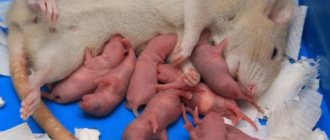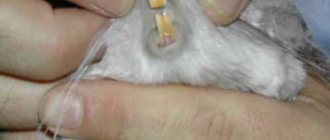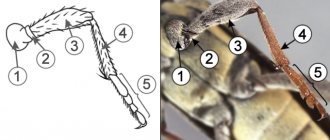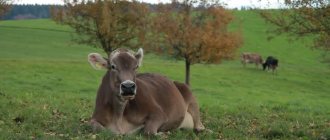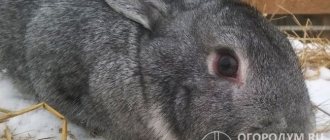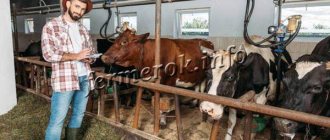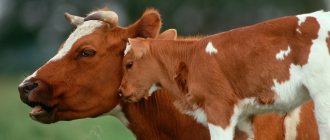Prenatal period in a chinchilla
On average, chinchilla pregnancy lasts about 120 days. The exact period depends on the breed, age and physiological characteristics of the female’s body. Most often there are up to four cubs in a litter.
A chinchilla can give birth to up to three litters per year, provided that estrus occurs at a normal interval - once every month and a half.
Some females are ready to breed twice a year or even once. However, many breeders advise not to have more than two litters from a female, since frequent births exhaust the body.
To ensure that the birth is successful and does not cause complications, fluoroscopy or ultrasound examinations should be performed late in pregnancy. By this time, the cubs have already formed and taken their position in the uterus. You can determine not only their size and quantity, but also the correct location. Based on the data received, each breeder can understand whether the help of a veterinarian will be needed or whether the female will cope on her own.
Preparing for childbirth consists of following the following rules:
- If the female lives with a male, two weeks before giving birth she is transferred to a separate cage,
- If the female is kept alone, a week before giving birth, the bottom of the cage is covered with a thick layer of clean and fresh hay,
- It is necessary to remove all unnecessary shelves in the cage, remove labyrinths and ladders,
- The temperature in the room with the cage should not fall below +20 and rise above +24 degrees,
- Two weeks before giving birth, they gradually begin to exclude concentrated feeds from the diet,
- With the exception of concentrates, the portion of hay and succulent feed is increased.
A little physiology
The chinchilla's reproductive cycle lasts 28 days. Mating is possible only during 3 days of estrus, when the female’s vagina is open and a special vaginal secretion is released. A couple is usually planted at night. If everything went well and after 30 days there is no new heat, it means that the female is most likely pregnant. However, it is impossible to say for sure, as it is very difficult to determine pregnancy at an early stage. The first sign, as already mentioned, is the absence of estrus. The second diagnostic method is regular weighing. Although in the first two-thirds of pregnancy the female slowly gains weight, in the last month the female rapidly gains weight. Another sign of pregnancy is that 8 weeks after erection, significant swelling of the nipples is observed. But the most accurate method is, of course, ultrasound or x-ray. Ultrasound examination allows you to accurately determine pregnancy in the early stages, but it is impossible to say exactly how many babies there will be. X-ray examination can be carried out only towards the end of pregnancy, when the babies’ skeletons have ossified, then the chinchillas can be counted.
How to determine the approach of labor
It is impossible to calculate the exact date of birth, but the preliminary date of birth is calculated by adding 115 days to the date of the last mating. The approach of childbirth can be noticed by a significant increase in the genital gap and swelling of the mammary glands. A few days before giving birth, the genital opening begins to open. At the same time, the females’ pelvic ligaments and abdominal muscles relax and stretch. All this can be noticed by the sagging of the abdomen.
Before birth, the loop swells
It is recommended to measure the animal's temperature daily using an anal thermometer. The day before birth, the temperature in the rectum drops noticeably.
It is not always possible to determine the approach of birth by the behavior of the female. Some females show anxiety, refuse food, and breathe frequently and intermittently. Others carefreely study objects in the cage, try to play, set up a nest and do not show any readiness for childbirth.
Species diversity
There are quite a few breeds of chinchillas and a variety of colors. To breed chinchillas at home, you need to choose only valuable colors, which cost from 8,000 rubles per child.
To choose the right male, you need to know the name of your breed. The male's coloration should roughly match the male's to ensure you get the right coloration in the cubs.
The main breeds of chinchillas:
- Albino;
- White recessive;
- White dominant;
- Pink and white;
- Beige dominant;
- Agouti;
- Foggy;
- Motley, etc.
To know which species can be crossed and which cannot, look at the genetic table.
The process of childbirth in a chinchilla
Most often, chinchillas give birth early in the morning. However, females that feel safe and have already given birth can give birth both during the day and at night. Immediately before giving birth, the female’s behavior changes dramatically: she becomes restless, can show aggression, constantly looks to her sides, moans or whistles. The prenatal period can last from several hours to a day.
When these symptoms occur, it is better to cover the cage with a dark cloth so as not to irritate the animal with light, sounds, or movement.
Contractions indicate that the female is beginning to give birth to babies. You can notice them by the wave-like contraction of the abdominal muscles. Rare and light contractions, expressed in periodic contractions of smooth muscles, stimulate the movement of the cubs in the desired direction. When babies find themselves in the uterine cavity, contractions become more frequent - the membranes rupture and amniotic fluid comes out. By this time, the genital slit is already completely open.
After intense contractions, there comes a turn of pushing, during which the smooth muscles of the abdomen contract. During the pushing, the baby is born. If contractions are an uncontrollable process, then the female can easily control the pushing herself. Most often, females give birth standing, resting their paws on the floor, but some prefer to give birth in a lying position or even on their side.
Attempts can continue for several hours. During normal labor, babies are born at intervals of fifteen minutes to two hours. During this time, the female manages to remove the film from the child, lick him and rest a little before the release of the placenta or the appearance of the next baby. If the intervals between attempts are less than fifteen minutes, then after the birth of one baby the female will not have time to remove the film, which threatens the death of the baby. In this case, the owner's assistance is required. His task is to carefully remove the film from the newborn and rub it with a clean napkin.
The afterbirth most often appears at the end of childbirth and is usually eaten by the female. This is explained by the content of important hormones in the afterbirth, which stimulate contractions of the uterine walls and milk production.
Pair formation
It is at this age that the reproductive system matures and animals can be distinguished by gender characteristics. In a male, there is a distance of several millimeters between the anus and the penis, but in a female, there is no gap between the vagina and the anus.
Chinchillas are polygamous animals and one male can cover three or four females. When forming pairs, the female is placed next to the male. Let's consider the difficult moment of forming a pair, because in severe cases rodents can seriously injure each other. What do we have to do:
- We place the pair in cages next door for a couple of days;
- Next, we place the animals in a small carrying cage for several hours;
- At this time, we prepare the cage for mutual living, change the filler and carry out general cleaning;
- We launch the first male to prepare and mark the territory;
- And last we launch the female.
This scheme will help avoid conflict situations.
Complications during childbirth
Complications are usually caused by:
- Large cubs
- Early pregnancy
- Injuries received during the period of gestation,
- Incorrect position of the cubs,
- Diseases.
What to do if your chinchilla has problems during childbirth? If the problem is that the fetus is stuck, you need to lubricate the baby’s body with Vaseline and carefully pull it out in time with the contractions. This will only happen when part of the baby has already emerged from the vagina. If the problem is associated with a long period of time between attempts, weakening of labor, convulsions during childbirth, very restless behavior of the female and an abundance of blood, you must immediately consult a doctor. You won’t be able to cope with these problems on your own at home without the help of a specialist, and in some cases surgical intervention is necessary.
Is it profitable to breed chinchillas for sale: reviews from owners, diagram
Maxim, Vladivostok, 38 years old
The idea of breeding chinchillas for sale came to us spontaneously. Before this, there was just a couple living with us, and the female was pregnant. We bought the necessary cages for them (at first we lived together), various food and other supplies. Initially, together with the animals, it cost us 25 thousand rubles. The first birth went well - 2 puppies. We also spent on a cage and food. During subsequent births, the female decided to eat her puppies. Next time we watched all night. After about 1.5 years, in the end we already had 3 females with 2-3 litters. It was necessary to install a split system because the livestock had grown and they did not like the heat. We did this in the apartment. But trouble struck again - the cubs began to get sick, and the slightest changes in food led to dulling of the fur. Vitamin supplements corrected the situation a little. But expenses began to rise, and there was no income yet. My wife and I got into debt. In total, we spent more than 600 thousand on their maintenance. We were able to sell all the chinchilla puppies, and then decided to sell the adults as well. But at absolutely not the price we expected. And we earned as much as 156 thousand rubles from them! Draw your own conclusions.
Approximate diagram
Victoria, Ekaterinburg, 31 years old
I have had chinchillas for over 5 years. I breed them not so much for money, I just like these animals. We have a private house - there is a lot of space, my husband made 2 large display cases himself. For the first 3 years, selling puppies did not bring much profit, but we did not strive for this. Then we kept another pair for ourselves, space allowed. But we gave them a whole room. There were complications, but my trusted veterinarian could give advice over the phone and even come at night. The second firstborn gave birth for a very long time. I can’t give exact numbers, but on average we spent about 20 thousand on them. This includes all materials. But, I repeat, we did a lot on our own - significant savings on these same cells. And now, after 5 years, in total we earned a little more than 30 thousand from the sale. Basically, we sold it to maintain the house at an affordable price. Therefore, my conclusion is that you can make money on them if you have a lot of space and this is not your specific goal. Gradually, gaining new knowledge, you can expand your production.
Postpartum period
Females who have given birth for the first time often experience postpartum stress. For them, what is happening is not entirely clear. This can be noticed by restless behavior, aggression and rejection of children. Usually the maternal instinct is still stronger and the female accepts the cubs after some time.
Therefore, do not panic if immediately after giving birth the chinchilla refuses to feed the babies.
Just a day after the chinchilla gave birth, she is already ready for another mating. However, this will lead to a lot of stress. Therefore, if the female gave birth in the same cage with the male, he must be placed in another cage for two to three days. After three days, the male can be returned home - he will help the female take care of the cubs.
The diet of a nursing chinchilla is not much different from the diet before and during pregnancy. It is recommended to feed the female with the most pure and vitamin-rich food possible. It’s good to add cottage cheese, milk (powdered) and fresh eggs to your diet. It is recommended to make an additional feeder for nettles, leaves and fruits of rose hips, hawthorn and strawberry leaves, which is placed next to the nest. An additional drinking bowl is also hung next to the nest.
The chinchilla has three pairs of nipples, but not all of them are active. Most often, the first and second pair are dairy. If babies suck nipples, then even in inactive ones milk appears over time. The breeder needs to monitor the feeding of the pups, since sometimes not all puppies have enough milk. Strong cubs often push away weak ones, which leads not only to slower growth and development, but also to death. If some puppies are stunted, they need to be artificially fed.
For feeding, use a mixture of one part unsweetened condensed milk and two parts chamomile infusion.
The mixture is heated in a water bath to room temperature and the babies are given small portions from a syringe without a needle several times a day.
10-14 days after giving birth, the female can return the shelves and all the toys to her cage. The cubs have already grown up enough and do not need constant maternal care - they begin to explore the cage, play, and try adult food.
Caring for a pregnant woman
In order for pregnancy and childbirth to proceed without complications, the expectant mother will need to create comfortable living conditions. To do this, just follow the following recommendations:
- Ensure complete peace in the room with the cage. The female should not be disturbed by loud noises or unexpected guests. You also need to make sure that the cage is not exposed to direct sunlight and that the room is not hot.
- Remove the running wheel, shelves, ladders, and hanging hammocks from the cage - this will protect your pet from falls. It is also better to remove the tunnels, since the female can get stuck in them.
- Clean the cage daily. In unsanitary conditions, the animal can get sick, as a result of which future babies will suffer.
- Introduce more high-calorie foods into the expectant mother's diet - cereals, fruits, vegetables, dried fruits. And also protein dishes (kefir, yogurt, crumbly cottage cheese).
- Provide your pet with warm bedding in the form of hay or wood filler.
Additionally, you will need to limit tactile contact with the pregnant chinchilla. If there is no need, you should not pick her up or let her out of the cage for a walk.
Particular attention will have to be paid to the health of the female. Ideally, during pregnancy she should undergo 2-3 routine examinations at the veterinary clinic. This includes an x-ray, which will help determine the number of babies and their presentation, as well as identify possible problems.
A pregnant chinchilla should never be lifted by its tail. This will become a real stress for her and can provoke premature birth.
Malposition
The newborn comes out feet first. There is a risk that the baby will suffocate if he gets stuck. The chinchilla will try to pull the baby out on its own, grabbing it with its teeth. In this case, the process runs the risk of being delayed, and the hind legs or tail of the newborn will be damaged. Help the woman in labor. With one hand, use your palm to support the female's stomach, with the other hand, gently pull the baby by the legs and body, twisting him clockwise. There may be injuries, but it is necessary to remove the fetus in order to save the mother chinchilla.
Here is an example of difficult births from the practice of our nursery:
| 11.00 o'clock, morning | The chinchilla began to sit down to give birth, she pushed, but could not give birth. They massaged the abdomen several times. |
| 13.30 | The first baby walked feet first, i.e. from the wrong position. I had to help, pull it out with my hands. The baby later did not survive due to birth trauma. The weight of the newborn is 60 grams. |
| 16.30 | The second baby was born head first. Before this, they did a stomach massage. Newborn weight 60 g. |
| 17.15 | The third baby was born head first. No massage needed. The baby was born in the membrane of fetus, which was removed, the lungs were opened and the chinchilla was dried. The weight of the newborn is 58 g. |
Readiness for mating (estrus)
Like many animals, female chinchillas have a period of estrus (hunting) when they are ready to mate and, moreover, desire it. On average, estrus lasts from 2 to 5 days, then the mating process may become unsuccessful.
Determining whether a chinchilla has started hunting is not difficult. Her behavior gives her away very much; she begins to throw everything around and creates complete chaos in her cage. Along with active behavior, the female eats very little or not at all.
The second sign is external signs. The genitals swell and become bright pink.
